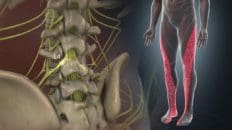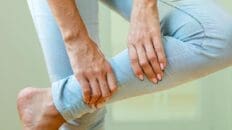Plantar Fasciitis pain can be extremely uncomfortable. What happens is a strain or rupture occurs on the connective tissue in the sole of the foot. This is known as the platar fascia. Plantar fasciitis can cause pain to many athletes and create discomfort when performing their sport. Typically, the pain occurs most as the foot is lifting in preparation to take its next step. The stretch happens right in the middle of the arch during that time or in the heel area. Individuals who suffer from platar fasciitis pain often need to take measures to get the pain under control. Therapies include ice baths, avoiding shoes that are too flexible or too tight, and wearing custom 3-D printed foot orthotics. Custom 3-D printed foot orthotics are a great approach to dealing with any kind of foot or low back pain. The orthotics are made by first having patients stand on a high tech footlevelers kiosk that sends an inferred light through. This measures the places patients are putting pressure on their feet as well as the differences they may have in their arches. From here, we are able to see a comprehensive view of the patient’s alignment in their feet, ankles, knees, hips, and spine. These scans also provide information regarding the patient’s posture. All of these issues may seem small but they all stem from the feet and the arches. Those with platar fasciitis will greatly benefit from using technology such as this. By providing pressure in the correct areas of the foot, the orthotic will work at a biomechanical level. Dr. Alexander Jimenez makes it a point to have all his patients scanned. With this information, they become informed of their feet and the pressure points that could be causing underlying issues. – Kenna Vaughn, Senior Health Coach
I’m Dr. Kennedy, and I’m going to talk to you today about plantar fasciitis, which I know you know, is very, very common symptoms and presentation. They have pain in the arch or in the heel area.
And the definition, acute or semi acute injury that occurs as a strain or partial rupture of the firm band of connective tissue, which is the plantar fascia on the sole, the foot etiology and excessive stretching of the plantar fascia may be produced by excessive long periods of foot pronation or landing hard on the sole, the foot or instant foot acceleration and deceleration. So upon examination, you’re going to find some swelling, possible spasm, gait distortion and loss of strength. Imaging, It’s negative initially. Chronic cases may show calcification at the calcaneal insertion. You won’t see muscle imbalances. Flexor digitorum brevis and all and anti pronators those supporting the arches. Management of this condition, of course you’re gonna manipulate the foot for biomechanical faults with emphasis on the calcaneus. Recommend daily ice sessions, usually 20 minutes followed by pain free ankle acute phase. Then you move into sports activity limited to pain tolerance, shock and pronation control with custom-made flexible orthotics based on biomechanical need. And on that note, I just think that without that step it’s really pointless to go any further, I think. You must have those custom orthotics, ankle strengthening, of course physiotherapy modalities that you would believe would help. And shoes can’t be too flexible or too tight. Any exercises? We also recommend the ankle series. And just as a side note, prevention obviously fit for their custom made flexible orthotics. And of course, based on biomechanical knee shock absorption and pronation controlling shoes and definitely encourage your patients not to run through this pain.
General Disclaimer
Professional Scope of Practice *
The information herein on "Reduction of Plantar Fasciitis Pain | Video" is not intended to replace a one-on-one relationship with a qualified health care professional or licensed physician and is not medical advice. We encourage you to make healthcare decisions based on your research and partnership with a qualified healthcare professional.
Blog Information & Scope Discussions
Welcome to El Paso's Premier Wellness and Injury Care Clinic wellness blog, where Dr. Alex Jimenez, DC, FNP-C, a board-certified Family Practice Nurse Practitioner (FNP-C) and Chiropractor (DC), presents insights on how our team is dedicated to holistic healing and personalized care. Our practice aligns with evidence-based treatment protocols inspired by integrative medicine principles, similar to those found on dralexjimenez.com, focusing on restoring health naturally for patients of all ages.
Welcome to El Paso's Premier Wellness and Injury Care Clinic & wellness blog, where Dr. Alex Jimenez, DC, FNP-C, a board-certified Family Practice Nurse Practitioner (FNP-C) and Chiropractor (DC), presents insights on how our team is dedicated to holistic healing and personalized care. Our practice aligns with evidence-based treatment protocols inspired by integrative medicine principles, similar to those found on dralexjimenez.com, focusing on restoring health naturally for patients of all ages.
Our areas of chiropractic practice include Wellness & Nutrition, Chronic Pain, Personal Injury, Auto Accident Care, Work Injuries, Back Injury, Low Back Pain, Neck Pain, Migraine Headaches, Sports Injuries, Severe Sciatica, Scoliosis, Complex Herniated Discs, Fibromyalgia, Chronic Pain, Complex Injuries, Stress Management, Functional Medicine Treatments, and in-scope care protocols.
Our information scope is limited to chiropractic, musculoskeletal, physical medicine, wellness, contributing etiological viscerosomatic disturbances within clinical presentations, associated somato-visceral reflex clinical dynamics, subluxation complexes, sensitive health issues, and functional medicine articles, topics, and discussions.
We provide and present clinical collaboration with specialists from various disciplines. Each specialist is governed by their professional scope of practice and their jurisdiction of licensure. We use functional health & wellness protocols to treat and support care for the injuries or disorders of the musculoskeletal system.
Our videos, posts, topics, subjects, and insights cover clinical matters, issues, and topics that relate to and directly or indirectly support our clinical scope of practice.*
Our office has reasonably attempted to provide supportive citations and has identified the relevant research studies or studies supporting our posts. We provide copies of supporting research studies available to regulatory boards and the public upon request.
We understand that we cover matters that require an additional explanation of how they may assist in a particular care plan or treatment protocol; therefore, to discuss the subject matter above further, please feel free to ask Dr. Alex Jimenez, DC, APRN, FNP-BC, or contact us at 915-850-0900.
We are here to help you and your family.
Blessings
Dr. Alex Jimenez DC, MSACP, APRN, FNP-BC*, CCST, IFMCP, CFMP, ATN
email: coach@elpasofunctionalmedicine.com
Licensed as a Doctor of Chiropractic (DC) in Texas & New Mexico*
Texas DC License # TX5807
New Mexico DC License # NM-DC2182
Licensed as a Registered Nurse (RN*) in Texas & Multistate
Texas RN License # 1191402
ANCC FNP-BC: Board Certified Nurse Practitioner*
Compact Status: Multi-State License: Authorized to Practice in 40 States*
Graduate with Honors: ICHS: MSN-FNP (Family Nurse Practitioner Program)
Degree Granted. Master's in Family Practice MSN Diploma (Cum Laude)
Dr. Alex Jimenez, DC, APRN, FNP-BC*, CFMP, IFMCP, ATN, CCST
My Digital Business Card




















